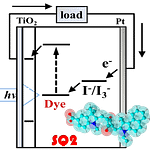5-carboxy-2-[[3-[(2,3-dihydro-1,1-dimethyl-3-ethyl-1H-benzo[e]indol-2-ylidene)methyl]-2-hydroxy-4-oxo-2-cyclobuten-1-ylidene]methyl]-3,3-dimethyl-1-octyl-3H-indolium 2024 Papers List
親水性から疎水性まで調整可能であり、植物細胞のバイオイメージングでは、疎水性のSQ1が細胞壁、両親媒性のSQ2が液胞と核、親水性のSQ3が液胞を選択的に染色することが確認されました。また、SQ2は色素増感太陽電池(DSSCs)においてエネルギー移動による光電変換効率の向上に寄与しました。さらに、スクアレインをリンカーとするTi-MOFsは、高効率な光触媒水分解を実現し、持続可能なエネルギー生産に貢献します。炭素ナノチューブファイバー(CNTFs)を用いたセンサーでは、アニオン検出の高感度化が達成されました。これらの研究は、構造-特性関係の理解を深め、エネルギー、環境、バイオの分野で革新をもたらしています。
Aniline-based squaraines (SQs) are groundbreaking materials demonstrating versatile applications based on their structural properties. SQs, adjustable from hydrophilic to hydrophobic, have shown selective staining capabilities in plant cell bioimaging: hydrophobic SQ1 stains cell walls, amphiphilic SQ2 stains vacuoles and nuclei, and hydrophilic SQ3 stains vacuoles. Additionally, SQ2 has contributed to enhanced photoelectric conversion efficiency in dye-sensitized solar cells (DSSCs) through energy transfer mechanisms. Furthermore, squaraine-linked Ti-MOFs have achieved highly efficient photocatalytic water splitting, advancing sustainable energy production. In carbon nanotube fiber (CNTF)-based sensors, SQs enabled high-sensitivity anion detection. These studies deepen our understanding of structure-property relationships and drive innovation in energy, environmental, and bio-related fields.

